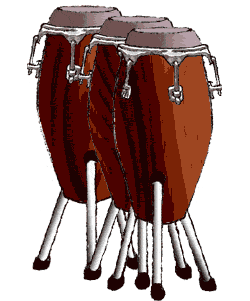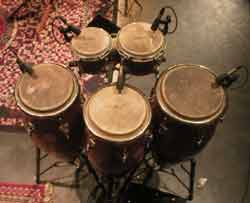Congas
The word, "Conga" is accually a misnomer. Although "Conga" is the name most commonly used for these drums, Conga really refers to the middle sized drum in a set of drums called "Tumbadoras".
Tumbadoras
make-up a family.
"Quinto", the "Boy"
is
the smallest.
"Conga", the "Father" is the middle sized-drum
and "Tumbadora" the "Mother"
is the largest of the three.
Some players bring in one or two more drums; a Nino or perhaps a lower
drum called a "Super Tumba" but Bones prefers to use a pair of Bongos in his set-up.
He uses a combination of Traditional Patterns with his own rhythmical
slant
to spark any dance-floor.

 |
As
he looks at the audience, Bones plays a "Quinto" in the middle, "Conga" on the left and a "Tumba" on the right with "Macho" and "Hembra" Bongos in the middle. |
Congas,
as they are most commonly refered to, are originally from Africa. Congas, and
drums as a whole, were forbidden to African's who were captured and taken to the
Caribbean during the Slave Trade. Slaves kept the traditional drumming alive through
the passing down of songs and rhythms orally and playing on anything close at
hand. Cajons (or Boxes in English) and Hoe Blades are now accepted instruments
in Afro-Cuban music.